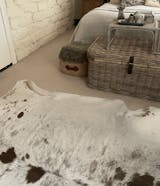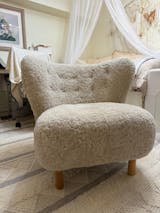
Innovative Ways on How to Hang a Cowhide Rug on the Wall
alicia bengenShare
Innovative Ways on How to Hang a Cowhide Rug on the Wall
Exploring how to hang a cowhide rug on the wall opens up a world of creative possibilities for using these versatile pieces in your home decor. Whether you're adding warmth to your living room, elevating your bedroom decor, or enhancing your dining table area, cowhide rugs offer endless opportunities.
Cowhide rugs are renowned for their versatility and distinctive texture, making them a favorite in western home decor not just for their traditional purpose as area rugs but also for their spectacular impact as wall decorations and more. In this detailed guide, we'll explore various creative methods on how to hang a cowhide rug on the wall, integrate them into ceilings, and repurpose them in unconventional ways around your home. Each section provides a step-by-step approach, backed by factual information and linked to both internal and external resources for further reading.
Section 1: Hanging Cowhide Rugs on the Wall
Why Choose Cowhide for Wall Art?
Cowhide rugs, such as Brindle Cowhide Rugs and White Cowhide Rugs, feature unique patterns and colors. Their durable nature makes them suitable for wall hanging, and they can even complement western decor. The lightweight yet sturdy structure of genuine cowhide ensures they can hang beautifully without damaging the material, even on drywall.
How to Hang a Cowhide Rug on the Wall with frame:

- Consider using a custom frame to complement the rug’s natural edges. This method not only preserves the hide but also gives it a polished look that resembles fine art. A tricolor cowhide offers a bold and captivating contrast with its natural blend of black, brown, and white tones, adding dynamic energy to any art piece. When paired with champagne or neutral shades like gray and beige, it complements minimalist interiors beautifully—creating a space that feels clean, refined, and subtly luxurious. This combination reflects the owner's taste for deluxe elegance with a low-profile sophistication, perfectly balancing warmth and modern simplicity.

Tools Needed:
- Measuring tape
- Picture frame (custom-sized to fit the cowhide)
- Staple gun (for securing the cowhide to the frame back)
- Rug Hanger, wall anchors, and screws (for hanging the frame)
- Direct Hanging: Use durable clips and discreet small nails to secure the rug directly to the wall. Position the nails at strategic points where the hide naturally lays flat against the wall to prevent curling and maintain the hide’s shape.

How to Hang a Cowhide Rug on the Wall:
Hanging a cowhide rug on the wall transforms it from a floor accent into a stunning focal point, effortlessly blending art and nature. And the best part? It’s super easy to do at home!
Watch this video to see how simple it is to hang a cowhide rug on your wall. You can easily complete this stylish upgrade in under 30 minutes!
Add texture, warmth, and a touch of luxury to your space today!
Tools Needed:
- Hammer, heavy duty stapler
- Nails
- Level (to ensure the cowhide hangs straight)
- Thicker nail (if required for heavier rugs)
- Stud finder (optional, for locating studs in the wall)

Section 2: Cowhide Rugs as Ceiling Accents
Why Cowhide Works on Ceilings:
The flexibility and form of genuine cowhide allow it to adapt to flat or even slightly curved surfaces, such as ceilings, adding warmth and texture overhead. Imagine a Grey Brindle Cowhide or Black Cowhide Rug as a statement piece above your dining table.
Installation Tips:
Secure Mounting: Use strong adhesive hooks or professionally install a mounted track system that can hold the weight of the hide, ensuring it stays in place without sagging.
Tools Needed:
- Drill
- Screw hooks or ceiling anchor bolts
- Strong fishing line or decorative chains (for suspension)
- Ladder

Section 3: Cowhide as Functional Art
Using Cowhide in Multi-Functional Roles:
-
Room Dividers:
A cowhide rug can serve as a dynamic room divider. Hang it from a ceiling-mounted rail system to add an artistic barrier in open floor plans. This works well with Large Cowhide Rugs like White Belly Cowhides or Calf Hide rugs.
Tools Needed:
- Ceiling track system (like those used for curtains)
- Hooks or clamps to attach the cowhide to the track
- Drill and screws for installing the track
-
Decorative Headboards:
Attach a Beige Cowhide Rug or Cream Cowhide Rug to a bedroom wall where it doubles as a soft, textural headboard.
Tools Needed:
- Drill
- Wall anchors and screws (to secure the cowhide)
- Adhesive wall hooks (for an easier installation option)
Why This Works: Cowhide’s durability and ease of maintenance make it ideal for high-touch areas, providing both aesthetic appeal and practical functionality.
Section 4: Non-Traditional Uses of Cowhide Rugs
Innovative Ideas:
-
Furniture Throws:
Draping cowhide over furniture is not just for aesthetics; it also protects the furniture with its tough yet smooth surface. A Goat hide Rug or Animal Print cowhide can bring rustic elegance to any space.
-
Outdoor Spaces:
Although not a traditional method, weather-resistant treated cowhide skin rugs can be used in covered outdoor areas to add rustic charm, especially in New Zealand or western style homes.
Tools Needed:
- Weather-resistant spray (if not already treated)
- Hooks or outdoor-safe hanging mechanisms
Why Cowhide is Suitable: The natural oils in cowhide make it resistant to dust and staining, which is ideal for both indoor and outdoor use.

Embracing cowhide in non-traditional ways not only showcases its versatility but also highlights your creative flair in home décor. From walls to ceilings and beyond, cowhide rugs like RODEO Rugs or Patchwork Rugs offer endless possibilities to enhance your living spaces.
How to Hang a Cowhide Rug on the Wall or use it in other creative ways is entirely up to you. Whether you're looking for a new cowhide rug, a Skin Rug for your living room, or adding a perfect wall hanging in western decor, you'll find the best ways to do so with high quality and great quality genuine leather products from Rodeo Rugs. Explore our Sale Price items, enjoy Fast Shipping, and check out our Customer Reviews for the best selection results. Add items to YOUR CART and experience the charm of genuine cowhide in your home today.
Have these insights inspired you to rethink how to hang a cowhide rug on the wall or perhaps try one of these other unique decorating ideas? Visit our site for more home improvement ideas and explore the Clearance Sale for great deals on Western Style decor.
You may also like:
5 Most Common Ways to Use a Cowhide Rug to Style Your Home: A Guide to Chic Decor




